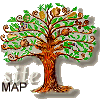- "BAREBACKS" A term used to describe an "as found" drawing (usually floor plan, elevation or section) that is complete with the exception of dimension lines, dimensions and annotations.
- ELEVATION The orthographic projection of a vertical element (building wall, façade or detail such as a door or window) onto a vertical picture plane. Elevations are identified by compass reference, ie., a north elevation is the view of the wall which faces in a northerly direction.
- EXPLODED VIEW A pictorial illustration (usually isometric) of a construction detail in which the various parts are displaced from their actual positions to show the sequence and relationship of assembly.
- ISOMETRIC PROJECTION A simple method of pictorial illustration similar to perspective but without foreshortening used primarily to show construction details.
- ORTHOGRAPHIC PROJECTION The method of producing an image or view of an object by projecting points of the object onto an imaginary picture plane such that all projections are at right angles to the picture plane. The importance of this method is that lines of the object that are parallel to the picture plane are true length in the resulting view. They can therefore be drawn to scale.
- PERSPECTIVE The science dealing with the apparent diminution in the size of objects as they recede from the spectator. Perspective projection is the geometric method of producing this effect in a line drawing, given the dimensions of the object and the position of the observer. Dimensions cannot be "taken off" perspective drawings because the various parts are at constantly varying scales (also known as foreshadowing).
- PICTURE PLANE An imaginary plane surface usually considered to be placed between the viewer and the object onto which rays from points on the object are projected in order to produce a view. The drawing paper is in the picture plane.
- PLAN (plan view) An orthographic projection onto a horizontal picture plane typically of the site, floor levels, and roofs of buildings. See also "SECTION".
- PLINTHS The projecting base of a wall. The square block at the base of a column or pedestal.
|
 |
- REFLECTED CEILING PLAN A plan view of a ceiling drawn as it would appear in a mirror placed on the floor below it, or in other words, a plan view drawn looking downwards. As such the reflected ceiling plan bears a direct relationship to floor plan of the room.
- SCALE The ratio of the size of an object as drawn, to the actual size of the object. In an orthographic projection, all true length lines are drawn to this constant ratio, i.e. "to scale". Common scales are given in Appendix II.
- SECTION (or sectional view) An orthographic projection created when the picture plane is imagined to cut through the object at a convenient location to illustrated internal structure or detail. Floor plans are a specific type of section where the picture plane is horizontal, usually one meter above floor level, and the viewing direction is downwards.
- TRUE LENGTH A true length line in orthogonal projection is defined by two points each of which is equidistant to the picture plan as measured at right angles to the picture plane.
- WAINSCOTTING A wooden lining of walls of rooms often covering the lower part only of the wall.
- WATER TABLE A ledge or offset on or above a foundation wall formed to shed water.
- CORNICE A projecting ornamental moulding along the top of a building.
- PICTURE RAIL A moulding fastened to the surface of an interior wall at or above door head height for the purpose of hanging pictures.
- SOFFIT The underside of any architectural element.
- THEODOLITE A surveying instrument used for measuring horizontal (and vertical) angles.
- TRAVERSE A surveying procedure consisting of the measurement of distance and angles between fixed points (stations) and the mathematical reduction of this data to enable the positions of the stations to be plotted.
|







